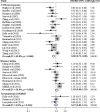Vitamin D status and risk of non-Hodgkin lymphoma: An updated meta-analysis
- PMID: 31034511
- PMCID: PMC6488072
- DOI: 10.1371/journal.pone.0216284
Vitamin D status and risk of non-Hodgkin lymphoma: An updated meta-analysis
Abstract
Purpose: This meta-analysis aimed to extensively investigate the association between various measures of vitamin D status and non-Hodgkin lymphoma (NHL) and its subtypes.
Methods: We searched MEDLINE (PubMed), Embase, and the Cochrane Library in February 2018. Two authors independently reviewed and selected articles based on predetermined criteria.
Results: A total of 30 studies with 56,458 NHL cases were finally selected, with 24, 9, and 3 studies on sunlight/ultraviolet radiation (UVR) exposure, dietary intake, and serum/plasma 25-hydroxyvitamin D levels, respectively. Significant protective effects of overall sunlight/UVR exposure on NHL and subtypes were observed, with summary relative risks (RRs) ranging from 0.67-0.80 (RR for NHL = 0.80; 95% confidence interval [CI]: 0.71-0.90) among subjects with high exposure compared to those with low exposure. The results were consistent with various classifications of sunlight/UVR exposure. In contrast, when exposure measures of dietary vitamin D intake (RR for NHL = 1.03; 95% CI: 0.90-1.19) and serum/plasma 25-hydroxyvitamin D levels (RR for NHL = 0.97; 95% CI: 0.82-1.15) were used, risk estimates were inconsistent or non-significant for NHL and the subtypes.
Conclusion: While risk estimates varied by different measures of vitamin D status, a protective effect of sunlight/UVR exposure on NHL incidence was verified, across most of the tested subtypes as well as exposure categories.
Conflict of interest statement
We have the following interests. Hye Yin Park, Kyoungho Lee and Jaewoo Koh are affiliated to Samsung Electronics Co. Ltd. (HYP, KL, JK - Samsung Health Research Institute, Samsung Electronics Co. Ltd.; HYP, Y-CH - Institute of Environmental Medicine, Seoul National University Medical Research Center; Y-CH - Department of Preventive Medicine, and Environment Health Center, Seoul National University College of Medicine). There are no patents, products in development or marketed products to declare. This does not alter our adherence to all the PLOS ONE policies on sharing data and materials, as detailed online in the guide for authors.
Figures


Similar articles
-
Sunlight exposure in association with risk of lymphoid malignancy: a meta-analysis of observational studies.Cancer Causes Control. 2021 May;32(5):441-457. doi: 10.1007/s10552-021-01404-6. Epub 2021 Feb 19. Cancer Causes Control. 2021. PMID: 33606147
-
Vitamin D status and risk of non-Hodgkin lymphoma: a meta-analysis.Cancer Causes Control. 2014 Nov;25(11):1553-63. doi: 10.1007/s10552-014-0459-2. Epub 2014 Aug 23. Cancer Causes Control. 2014. PMID: 25148916
-
Sunlight exposure, vitamin D, and risk of non-Hodgkin lymphoma in the Nurses' Health Study.Cancer Causes Control. 2011 Dec;22(12):1731-41. doi: 10.1007/s10552-011-9849-x. Epub 2011 Oct 11. Cancer Causes Control. 2011. PMID: 21987081 Free PMC article.
-
Adulthood residential ultraviolet radiation, sun sensitivity, dietary vitamin D, and risk of lymphoid malignancies in the California Teachers Study.Blood. 2011 Aug 11;118(6):1591-9. doi: 10.1182/blood-2011-02-336065. Epub 2011 May 26. Blood. 2011. PMID: 21622649 Free PMC article.
-
Sun exposure, vitamin D, and risk of Hodgkin and non-Hodgkin lymphoma.Nutr Cancer. 2010;62(7):878-82. doi: 10.1080/01635581.2010.509535. Nutr Cancer. 2010. PMID: 20924963 Review.
Cited by
-
Rehabilitation in patients with lymphoma: An overview of Systematic Reviews.J Rehabil Med. 2021 Mar 17;53(3):jrm00163. doi: 10.2340/16501977-2810. J Rehabil Med. 2021. PMID: 33710351 Free PMC article.
-
Sunlight exposure in association with risk of lymphoid malignancy: a meta-analysis of observational studies.Cancer Causes Control. 2021 May;32(5):441-457. doi: 10.1007/s10552-021-01404-6. Epub 2021 Feb 19. Cancer Causes Control. 2021. PMID: 33606147
-
Environmental effects of stratospheric ozone depletion, UV radiation and interactions with climate change: UNEP Environmental Effects Assessment Panel, update 2019.Photochem Photobiol Sci. 2020 May 20;19(5):542-584. doi: 10.1039/d0pp90011g. Photochem Photobiol Sci. 2020. PMID: 32364555 Free PMC article. Review.
-
Seasonal variation in the incidence of primary CNS lymphoma.Neurooncol Pract. 2020 Jul 1;7(6):620-625. doi: 10.1093/nop/npaa038. eCollection 2020 Dec. Neurooncol Pract. 2020. PMID: 33312676 Free PMC article.
-
Prognostic value of 25-hydroxy vitamin D in extranodal NK/T cell lymphoma.Ann Hematol. 2021 Feb;100(2):445-453. doi: 10.1007/s00277-020-04320-y. Epub 2020 Nov 2. Ann Hematol. 2021. PMID: 33140135 Clinical Trial.
References
Publication types
MeSH terms
Substances
LinkOut - more resources
Full Text Sources
Medical

